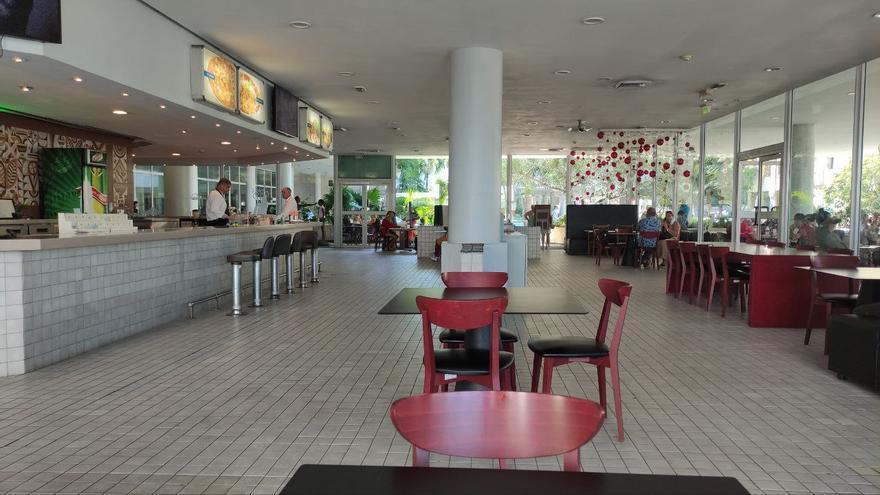
![]() 14ymedio, Juan Diego Rodríguez, Havana, 7 September 2022 — The La Rampa cafeteria, with its terrace protected from the flow of 23rd street, has known better times. Located in the Habana Libre hotel, it has suffered the same fate as the establishment that hosts it and has become a small restaurant of little heritage, whose prices give no respite to the hungry citizen.
14ymedio, Juan Diego Rodríguez, Havana, 7 September 2022 — The La Rampa cafeteria, with its terrace protected from the flow of 23rd street, has known better times. Located in the Habana Libre hotel, it has suffered the same fate as the establishment that hosts it and has become a small restaurant of little heritage, whose prices give no respite to the hungry citizen.
The old Hilton, destined to be one of the most luxurious on the continent, opened its doors in 1958 and was nationalized by Fidel Castro only two years later. Time and underdevelopment have reduced its category rating many times, but nothing, not even the resounding Special Period, compares to the debacle it’s going through today, which has already reached its dining establishments without adapting the prices to the poverty of the offerings.
At the entrance of La Rampa, the clerks place a black, battered banner with the menu of the day written in chalk. A ham and cheese sandwich costs 250 pesos; a juice, 100; depending on the amount, the coffee will cost 30, 60 or 70; and for those who are in the mood at the time to buy a drink of 150 pesos, you can choose among a mojito, a daikirí and a cuba libre.
There’s nothing more. Inflation and the lack of products pull each other down, so that not only is supply expensive, but there is no supply at all.
A maid, very busy scaring away two foreigners who have chosen her space, is slow to write down the request of Cubans. “This table is dirty,” scolds the woman, “you can’t sit here.” “So clean it,” they reprimand her. For them, the state of the cafeteria is inconceivable.
At last it’s possible to request something to eat and when, after a long wait, the food arrives at the table, the Cubans devour it quickly and bitterly. The “natural” juice is actually an artificial preparation to which too much ice has been added; the tiny bread, baked with whole wheat flour, is pale and tasteless. The worst: the cook had no scruples about frying “chopped” sweet potato flakes, bitten by insects, and the little insect pieces leave a black border.
The total cost of a lunch is 400 pesos. As the hotel is partially managed by the Gran Caribe company and not by the all-powerful Gaviota, there is still the option of paying in cash. Otherwise, you would have to present a magnetic card that not all Cubans have.
But that’s not all. There are other examples of the sad decline of the Habana Libre. The 25th and L sweet shop, before full of exquisite sweets even despite the pandemic, offers empty refrigerators, and only a few small, lackluster pieces are offered. “Thanks for the four sweets!” exclaimed an ironic customer on Wednesday. “Now if I want to buy cake, I’ll have to come when you open.”
The El Polinesio restaurant, which was once the gastronomic pride of the hotel, follows the same route as the cafeteria and the sweet shop.
As soon as he approaches the entrance of the premises, the customer is hit by the smell of moisture and accumulated fats stored on the carpet. Where before was the roasting area for its mythical barbecue chicken, which diners could see while it turned golden on the firewood, now there is only one useless area full of dust. From the decor that recalled the wildlife of Polynesia, there are a few masks left on the wall and some wooden logs covered with flies.
Despite this, you need to make a reservation to eat at the premises. “You have to call on the phone or come the day before,” clarifies one of the waiters. After the culinary disappointment at La Rampa, reading the Polynesian menu is enough not to eat there. All dishes exceed 300 pesos, and the famous chicken reaches 500, although it has little to do with the recipe of yesteryear.
Ordering a coffee or a sandwich in a hotel cafeteria and hanging out in a different environment was something acceptable even for some Cubans capable of making the economic effort in exchange for escaping routine and the heat of Havana.
Inflation and the recent measures of the Ministry of Economy to capture as much currency as possible have made this option impossible for the majority of the population, for whom even several salaries are not enough to cover a lunch.
“Where does the rope break? On the weakest side,” a social networks user commented this Friday, attributing to the “crazy monetary reorganization” his decision not to consume again in the prestigious Manzana, Parque Central, Packard or Paseo del Prado hotels. “Bye bye, cubanitos; bye bye, terraces of Havana,” he wrote. In the case of the Habana Libre, you can pay for luxury, but you can’t find it.
Translated by Regina Anavy
____________
COLLABORATE WITH OUR WORK: The 14ymedio team is committed to practicing serious journalism that reflects Cuba’s reality in all its depth. Thank you for joining us on this long journey. We invite you to continue supporting us by becoming a member of 14ymedio now. Together we can continue transforming journalism in Cuba.
